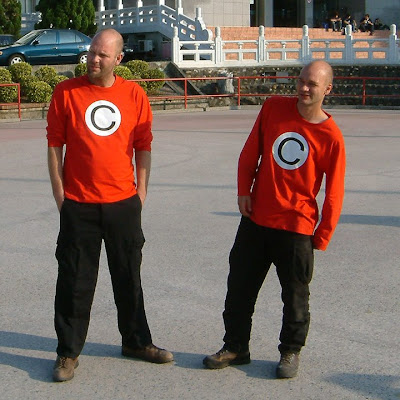Curator and Organizer of Taipei on the Move
Satirizing urban commercialism and industrialized society has been the consistent creative attitude of Marco Casagrande. His works integrate people, landscapes, the environment and action, presenting naked criticism of city spaces and human values. But in the background of his satire and criticism is hidden a limitless consideration of society and concern for humanity.
 C-Laboratory Taipei in 2004.
C-Laboratory Taipei in 2004.
One example is "Organic Layer_Taipei", in which he created a genuinely usable miniature organic city space on Treasure Hill. Continuing on with the creative concept of "Organic Layer_Taipei", Casagrande once again felt the pulse of Taipei, personifying the city's urban space, and delving deeply into its subconscious. He attempted through art and architecture to deconstruct the composition of Taipei's urban society, and to express the hopes and dreams of its inhabitants.

How did Casagrande, acting as psychological counselor, undertake the physical and psychological reconstruction of Taipei City?

Invoking a phrase from the classic film "Metropolis" - "The mediator between the head and the hands must be the heart" - he sought to create and interface in which the people of Taipei exchanged and conveyed information, and directly participated in city planning.

Thus, collaborating with Martin Ross, an artist who works principally with the medium of iron, he created eight "Trojan Rocking Horses". Tamkang University Architecture Department students carried these iron horses in a procession through every corner of Taipei City. The city's residents, intimately familiar with this living environment, wrote down their dreams, memories, thoughts and opinions, and threw them inside the horses.
 Martin Ross and Marco Casagrande marching towards the Taipei City Hall.
Martin Ross and Marco Casagrande marching towards the Taipei City Hall.
On November 11, the procession reached its final destination - Taipei City Hall, where Mayor Ma Ying-Jeou was invited to open the Trojan horses, and read aloud the messages coming from people at every level of society.
 Mayor Ma Ying-Jeou writing his personal message to the Trojan Rocking Horse.
Mayor Ma Ying-Jeou writing his personal message to the Trojan Rocking Horse.
"Trojan Rocking Horses" invited a large cross-section of the public to participate in a dialogue with the city, exploring a substantive, new perspective of the city centered on human beings, and conveying the outlook of the art project, "The Human Layer_Taipei". Casagrande's Trojan horses symbolized the urban nomadic reality of postindustrial times, serving as a metaphor for the instability of the relationship between modern people and the environment in which they exist.
 A Trojan Horse visiting the Taipei Museum of Fine Arts.
A Trojan Horse visiting the Taipei Museum of Fine Arts.
At the same time, he transformed the Trojan horses into a "public letterbox", contemplating the partnership relationship between the public and policy-makers, in an attempt to demarcate the boundaries of civic society. Casagrande's method, allowing art to serve public issues, was originally a risky undertaking, but he created a dialogue platform for sharing and exchange (a public letterbox), consciously guiding the public to discuss the current state of their surrounding living environments, and avoiding the trap of art serving the purposes of politics.
 Doctor Ai.
Doctor Ai.
In an interactive web site, Marco Casagrande adn his collaborators transmitted information on Taipei residents which they gathered in the various corners of the city, and reported their plan of action. Using the model of Internet dissemination, they introduced Taipei into a network of dialogue among cities around the globe.
Conclusion
Taipei on the Move mapped the human terrain of Taipei City through art. In the human space we wish to create, art is a method, a catalyst, a form of questioning. Adopting such a goal which has no hard and fast destinations, the designs of these five art workshops revealed the views and thoughts of the youth, women, senior citizens and ordinary residents of the city regarding themselves, society, culture and their environment.
 Ma Ying-Jeou and Marco Casagrande dressed in the height of fashion.
Ma Ying-Jeou and Marco Casagrande dressed in the height of fashion.Unlike most public events or performances, the Taipei on the Move workshops achieved the dual objectives of civic discourse and public pedagogy, becoming a new genre of public art.

This category of public art no longer is merely the expression of a single object or a group of objects within a space. Through the concept of new genre public art,
Taipei on the Move has presented alternative ways to explore questions of space, environment, education, ethnicity, gender and local identity.

Taipei on the Move, 2005. Editor Jo Hsiao. Department of Cultural Affairs, Taipei City Government, Taiwan 2005

 Marco Casagrande mounted on a Trojan Horse in Taipei.
Marco Casagrande mounted on a Trojan Horse in Taipei. The army of Trojan Rocking Horses standin in line, waiting for the attack, in the Tamkang University base camp.
The army of Trojan Rocking Horses standin in line, waiting for the attack, in the Tamkang University base camp. 
 Mayor Ma Ying-jeou, now the President of Taiwan (2008-), reading the Trojan Rocking Horse messages.
Mayor Ma Ying-jeou, now the President of Taiwan (2008-), reading the Trojan Rocking Horse messages. 




















